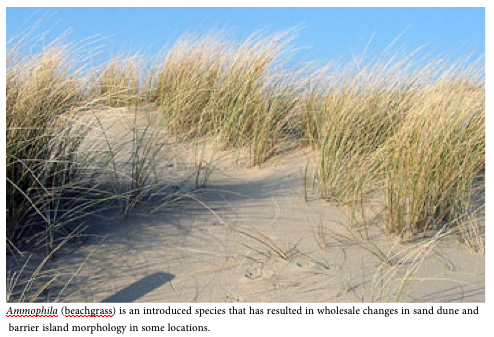Here in the University of Kentucky physical geography program, we have a regular weekly meeting called BRAG (Biogeomorphology Research & Analysis Group) in which various faculty and graduate students from geography and other programs cuss, discuss, debate, and speculate about a wide range of topics centered on geomorphology-ecology interactions. A couple of years ago we focused quite a bit on the biogeomorphic ecosystem engineering effects of invasive species. That led to development of a review paper, which at long last was published, in the Annual Review of Ecology, Evolution, and Systematics—The biogeomorphic impacts of invasive species. The co-authors are myself, Songlin Fei, and Michael Shouse. Songlin, now at Purdue University, was then in the Forestry department at UK, and a regular participant in BRAG. Michael, now at Southern Illinois University-Edwardsville, was then a geography PhD student here.
The abstract is below, and a ScienceDaily news release is here: http://www.sciencedaily.com/releases/2014/12/141211115522.htm
ABSTRACT: Invasive species, often recognized as ecosystem engineers, can dramatically alter geomorphic processes and landforms. Our review shows that the bio- geomorphic impacts of invasive species are common, but variable in magnitude or severity, ranging from simple acceleration or deceleration of preexisting geomorphic processes to landscape metamorphosis. Primary effects of invasive flora are bioconstruction and bioprotection, whereas primary effects of invasive fauna are bioturbation, bioerosion, and bioconstruction. Land- water interfaces seem particularly vulnerable to biogeomorphic impacts of invasive species. Although not different from biogeomorphic impacts in general, invasive species are far more likely to lead to major geomorphic changes or landscape metamorphosis, which can have long-lasting impacts. In addition, invasive species can alter selection pressures in both macroevolution and microevolution by changing geomorphic processes. However, the differing timescales of biological invasions, landscape evolution, and biological evolution complicate assessment of the evolutionary impacts of invasive organisms.

Songlin and Michael have much more experience and expertise in invasive species than I, but one of my interests is the coevolution of biota, ecosystems, landforms, and soils. In particular, I’ve been thinking about how the appearance of new organisms via speciation and dispersal at evolutionary time scales can lead to landscape metamorphosis. The documentation of profound biogeomorphic changes due to newly-introduced species provides a nice proof-of-concept in this regard.
Reference: Fei, S., Phillips, J.D., Shouse, M.A., 2014. Biogeomorphic impacts of invasive species. Annual Review of Ecology, Evolution, and Systematics 45: 69-87 doi: 10.1146/annurev-ecolsys-120213-091928.
